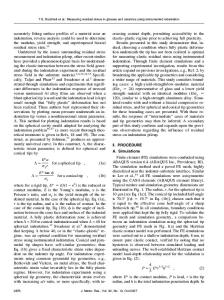The Indentation Load-depth Curve of Ceramics
- PDF / 439,015 Bytes
- 14 Pages / 612 x 792 pts (letter) Page_size
- 50 Downloads / 446 Views
MATERIALS RESEARCH
Welcome
Comments
Help
The indentation load-depth curve of ceramics M. Sakai, S. Shimizu, and T. Ishikawa Department of Materials Science, Toyohashi University of Technology, Tempaku-cho, Toyohashi 441-8580, Japan (Received 15 April 1998; accepted 2 August 1998)
The pyramidal indentation-induced surface deformation of brittle ceramics is examined on the basis of extensive test results for indentation load sPd-depth shd curves during loading/unloading cycle. A mechanically stiff test system is essential for obtaining P-h curves acceptable and reliable for subsequent analyses. Both the loading and unloading P-h curves are expressed by quadratic functions within experimental variations for all the indenters used (Vickers, Berkovich, and Knoop). The loading curve is then related to the Meyer hardness and the unloading curve to Young’s modulus by the use of semiempirical equations which enable one to estimate these moduli from the observed loading/unloading parameters. An elastoplastic constitutive equation for indentation surface deformation is theoretically derived. This equation not only predicts well the experimental observations but also gains an important physical insight into the Meyer hardness. The Meyer hardness of brittle materials is not a measure for plasticity, but an elastic/plastic parameter which significantly depends on the geometry of indenter. The concept and experimental determination of “true” hardness as a characteristic material measure for plasticity are proposed.
I. INTRODUCTION
The indentation load sPd-depth shd curve (P-h curve) during loading/unloading cycle gives all the information on the microscopic processes and mechanisms of surface deformation and failure.1,2 In brittle ceramics, the loading curve yields elastic/plastic deformation parameters, and the unloading curve has been utilized for estimating elastic parameters.3–27 The total area of the hysteresis loop enclosed by a P-h curve for indentation loading/unloading cycle, that is, the external work consumed to create an indentation impression, has also been used to provide energy-derived elastic/plastic parameters.1,8,18,27 The relation between the load P and the size d (chordal diameter) of remaining impression for spherical indenters has been expressed by a number of empirical relationships. The very first of these, referred to as Meyer’s law, states P kd n , where k and n are constants for the material under examination.28 The value of n generally lies between 2.0 and 2.5. For fully work-hardened metals, it is close to 2.0, and has a value near 2.5 for fully annealed metals. Meyer found in a very extensive series of spherical indenters with various diameters D that the index n was almost independent of D, but that k decreases with increasing D. He finally derived a simple empirical relation of Pyd 2 fsdyDd, where fsdyDd is a characteristic material function, and then concluded that Pyd 2 must be constant for “geometrically similar” impressions with a constant of dyD (“the principle of geometrical simila
Data Loading...











